
1960s cinema stands as a pivotal era in film history, marked by groundbreaking innovation and cultural shifts. This decade witnessed the emergence of new genres, iconic filmmakers, and timeless classics that continue to influence the industry today. From the rise of New Hollywood to the global recognition of foreign cinema, the '60s redefined what movies could be and how they were experienced. As audiences, we're still captivated by the daring narratives, stylistic experimentation, and the bold voices that emerged during this period. Whether you're a film buff or just curious about this transformative era, understanding these 20 facts will deepen your appreciation for 1960s cinema and its lasting legacy on the silver screen.
The Dawn of New Wave Movements
Cinema in the 1960s witnessed a seismic shift with the emergence of new wave movements across the globe. These movements, characterized by their radical approach to storytelling and filmmaking techniques, marked a departure from traditional Hollywood cinema.
-
French New Wave, or Nouvelle Vague, became synonymous with directors like Jean-Luc Godard and François Truffaut. Their films, such as "Breathless" (1960) and "The 400 Blows" (1959), introduced innovative narrative structures and visual styles.
-
In Italy, Italian Neorealism evolved into a more personal and introspective form, with Michelangelo Antonioni and Federico Fellini leading the way. Fellini's "8½" (1963) is a prime example, blending reality with imaginative storytelling.
-
The British New Wave brought the focus to the working class, with films like "Saturday Night and Sunday Morning" (1960) and "A Taste of Honey" (1961) showcasing gritty realism and social commentary.
Blockbusters and Technological Innovations
The 1960s also saw the rise of epic blockbusters, which captivated audiences with their grandeur and technological advancements.
-
"Lawrence of Arabia" (1962), directed by David Lean, is renowned for its breathtaking cinematography and innovative use of 70mm film, setting a new standard for visual storytelling.
-
Cinerama and other widescreen formats became more prevalent, offering viewers an immersive experience. "2001: A Space Odyssey" (1968) by Stanley Kubrick utilized these technologies to create stunning visual effects that were groundbreaking for its time.
-
The introduction of Panavision cameras allowed for sharper and wider images, enhancing the cinematic experience in films like "The Sound of Music" (1965).
Social and Cultural Reflections
Films in the 1960s often mirrored the social upheavals and cultural shifts of the era, addressing topics that were previously considered taboo.
-
"To Kill a Mockingbird" (1962) tackled racial injustice, while "Guess Who's Coming to Dinner" (1967) dealt with interracial marriage, both reflecting the growing civil rights movement in the United States.
-
The counterculture movement found its voice in films like "Easy Rider" (1969), which depicted the disillusionment of the youth with mainstream society.
-
Feminist themes were explored in movies such as "The Graduate" (1967), highlighting the changing roles and expectations of women during the 1960s.
International Cinema and Iconic Filmmakers
The 1960s were not just about American cinema; international filmmakers also made significant contributions, leaving a lasting impact on the global film landscape.
-
Japanese cinema flourished with directors like Akira Kurosawa, whose epic "Yojimbo" (1961) influenced Western filmmakers.
-
Indian cinema saw the rise of Satyajit Ray, whose "Apu Trilogy" concluded in the 1960s, cementing his status as a master storyteller.
-
Soviet director Andrei Tarkovsky's "Andrei Rublev" (1966) pushed the boundaries of cinematic art with its philosophical depth and visual poetry.
The Birth of Modern Horror and Sci-Fi
The 1960s also heralded the birth of modern horror and science fiction genres, with films that broke new ground in terms of content and special effects.
-
Alfred Hitchcock's "Psycho" (1960) redefined the horror genre with its psychological intensity and shocking twists.
-
"Night of the Living Dead" (1968) by George A. Romero introduced zombies to mainstream cinema, creating a new horror sub-genre.
-
"Planet of the Apes" (1968) combined science fiction with social commentary, using groundbreaking makeup effects to bring its story to life.
Animation Breakthroughs
Animation saw significant advancements in the 1960s, with both television and film embracing the medium in new and creative ways.
-
"The Flintstones" (1960), the first animated series to air in prime time, paved the way for future animated sitcoms.
-
Disney's "101 Dalmatians" (1961) introduced the use of Xerox technology to transfer animators' drawings directly onto cels, streamlining the animation process.
-
The Beatles' "Yellow Submarine" (1968) showcased innovative animation techniques and psychedelic visuals, reflecting the era's artistic experimentation.
The Legacy of 1960s Cinema
The innovations and cultural reflections of 1960s cinema have left an indelible mark on the film industry, influencing generations of filmmakers and audiences alike.
-
The decade's exploration of new narrative forms, visual styles, and thematic depth expanded the possibilities of what cinema could achieve.
-
As a result, the 1960s remain a pivotal era in film history, celebrated for its groundbreaking contributions to the art and craft of filmmaking.
A Final Curtain Call on 1960s Cinema
Diving into the vibrant world of 1960s cinema reveals a transformative era that reshaped entertainment and society. This decade introduced us to groundbreaking films, iconic stars, and revolutionary storytelling techniques that still influence filmmakers today. From the rise of New Hollywood to the global impact of foreign films, the '60s were a time of artistic experimentation and social commentary. Classics like "Psycho," "2001: A Space Odyssey," and "The Sound of Music" not only entertained but also challenged audiences to see the world through a different lens. As we look back, it's clear that this era's legacy is its enduring impact on cinema's power to inspire, provoke, and connect us across generations. So, here's to 1960s cinema—a time capsule of creativity, rebellion, and cinematic brilliance that continues to captivate film lovers around the globe.
Was this page helpful?
Our commitment to delivering trustworthy and engaging content is at the heart of what we do. Each fact on our site is contributed by real users like you, bringing a wealth of diverse insights and information. To ensure the highest standards of accuracy and reliability, our dedicated editors meticulously review each submission. This process guarantees that the facts we share are not only fascinating but also credible. Trust in our commitment to quality and authenticity as you explore and learn with us.


